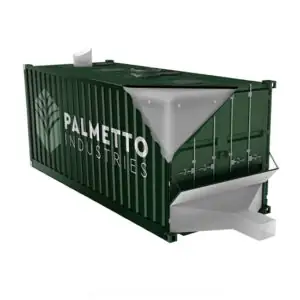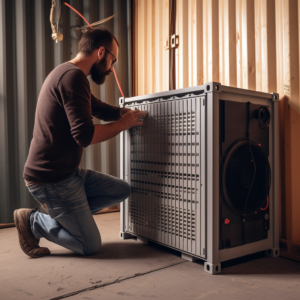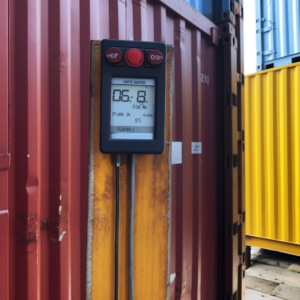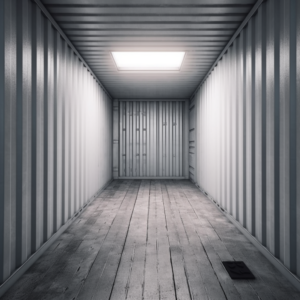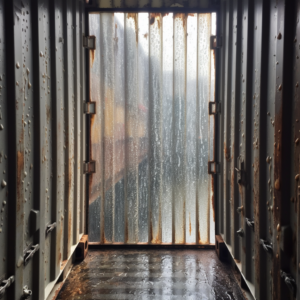How To Prevent Mold in Shipping Containers (Avoid Condensation)
There’s zero doubt that mold in shipping containers can cause havoc if left unattended. Even the slightest instance of mold can have severe financial and operational ramifications for your business.
But, it’s not actually the mold that’s the problem. The trick is to stop moisture from occurring in the first place.
So, how do you do this? Well, there are some very simple solutions…
Here’s how to prevent mold in storage containers for shipping
Mold grows in places with high moisture content, so it makes sense that to prevent mold, you should look to prevent moisture and condensation from growing in the first instance.
With this in mind, here are the current methods on how to keep moisture out of storage containers for shipping:
1. Use a container liner
Our shipping container liners are made from our moisture-resistant polypropylene, designed to create a barrier between the container walls and the items being shipped.
They act as a protective shield, preventing direct contact between the container walls and the cargo. This protective vapor barrier reduces the transfer of moisture and prevents excess moisture from condensing, promoting a more controlled environment.
Our liners are typically installed inside the container before loading the goods. Once installed, the liner forms a sealed enclosure around the cargo.
To learn more about how our container liners can help you prevent mold and protect the contents, get in touch with us.
2. Use a shipping container dehumidifier
A shipping container dehumidifier is specifically designed to control and reduce humidity levels within shipping containers. They can play a vital role in combating moisture-related problems such as condensation, mold growth, corrosion and the deterioration of goods during shipping and storage.
The primary function of a dehumidifier for a shipping container is to extract excess moisture from the air inside the container via either removing condensation or moisture-absorption.
Condensation-based shipping container dehumidifiers work by lowering the temperature inside using cooled coils. As air passes over the cooled coils, moisture in the air condenses and collects in a reservoir, while the dry air is released back into the container.
Absorption-based dehumidifiers use desiccant materials to absorb moisture from the air, significantly reducing the humidity level inside the container. Depending on the model, they may be battery-powered or designed to operate without electricity, making them suitable for situations where a power source is limited or unavailable.
3. Choose the right packaging materials
When packaging the contents for your shipping container, always opt for packaging materials that are resistant to moisture, such as plastic or moisture-resistant cardboard.
Avoid using materials that can easily absorb moisture, like regular cardboard.
4. Wrap items properly
Ensure that the items you’re shipping are properly wrapped and protected by using plastic wrap, bubble wrap, or protective packaging materials to create a barrier between the items and the container.
5. Use desiccant packets
If using an absorption-style dehumidifier isn’t your bag, moisture-absorbing desiccant packets inside your shipping container will help absorb any moisture and reduce humidity levels.
Be sure to use the appropriate amount of desiccant based on the container size, humidity level and the type of products being shipped.
It’s important to distribute the desiccant evenly within the container and place it near the goods to ensure maximum effectiveness.
Look to use around 5-10 grams of desiccant per cubic foot of container space, but you can calculate the amount more precisely using these steps:
- Determine the volume of the container in cubic feet by multiplying the width, height and length together.
- Multiply the container’s cubic foot volume from step 1 by 5-10 grams to determine the total amount needed.
- Divide the amount in step 2 by the size of individual desiccant packets to get the amount of packets you need.
6. Seal the individual contents with tape
Using a high-quality tape on the individual boxes/containers in the larger shipping container will help enforce a seal and prevent mold and mildew during transit.
High-quality tape is designed to withstand the rigors of transportation, including changes in temperature, humidity and handling. It offers superior adhesive strength, ensuring that the container remains tightly sealed throughout the journey.
To achieve a proper seal, ensure the surfaces being taped are clean and dry for maximum adhesion. Apply the tape along the seams and edges of the container, ensuring that it overlaps and covers any gaps or openings. Use sufficient pressure to firmly secure the tape in place.
7. Consider using moisture barriers
Moisture barrier bags or plastic shrink wrap provide an extra layer of protection, which is especially useful for shipping items that are sensitive to moisture, such as electronics or artwork.
Moisture barrier bags are specially designed to prevent moisture from penetrating the packaging. They’re typically made from polyethylene or nylon, which have excellent moisture resistance properties.
In addition, they create a barrier that shields the items from direct contact with moisture, preventing condensation or humidity from affecting them.
Shrink wrap can be applied directly to the items or used to wrap pallets, forming a tight seal around the items, offering protection from moisture, dust and other external elements.
It provides an additional layer of defense against moisture intrusion, ensuring that the items remain dry and intact throughout shipping.
8. Choose a reputable shipping service
The best shipping companies take proper precautions to handle and protect packages from moisture. More specifically, ensure that the shipping company has a good track record of delivering packages in a safe and dry condition.
9. Monitor temperature and humidity during transit
If you’re shipping items that are particularly sensitive to moisture, temperature and humidity-monitoring devices will alert you if there are any fluctuations in temperature or humidity levels that could promote mold growth.
These alerts can be sent via email, SMS or notifications on a dedicated monitoring platform or mobile application.
Examples of these devices are data loggers, wireless sensors and smart monitoring systems, all providing accurate and continuous monitoring.
Contact Us
How to treat shipping container mold in 7 steps
If you haven’t managed to prevent the build-up of moisture in the first place, container mold is the result, but all is not lost. It’s crucial to address the issue promptly and effectively to prevent further damage:
- Safety precautions: Before starting the treatment, ensure you wear protective gear, such as gloves, goggles and a mask, to protect yourself from mold spores.
- Remove affected items: Take out any items that are affected by mold and inspect them for damage. If they’re salvageable, clean and dry them separately. If they’re heavily contaminated or damaged, consider disposing of them.
- Clean the shipping container: Thoroughly clean the container’s interior using a solution of water and detergent. Scrub the affected areas with a stiff brush to remove visible mold growth. Be sure to reach corners, crevices and other hard-to-reach areas.
- Use a mold-killing solution: Apply a mold-killing solution, such as a mixture of water and bleach or a commercial mold remover, to the affected areas. Follow the manufacturer’s instructions and allow the solution to sit for the recommended time to effectively kill the mold.
- Dry the container: After cleaning and applying the mold-killing solution, ensure the container is completely dry. Use fans, dehumidifiers or natural ventilation to facilitate air circulation and remove excess moisture. This step is crucial to prevent mold from recurring.
- Prevent future mold growth: Implement preventive measures we discussed above to minimize the risk of mold growth in the future.
- Seek professional assistance if needed: If the mold is extensive or persistent, consult mold-remediation professionals who have the expertise and equipment to effectively treat and eliminate mold.
Don’t forget that the complete prevention of mold in the first place is feasible by using our shipping container liners. Contact us so we can discuss your situation further!
Contact Us
7 Causes of mold in shipping containers
Understanding the causes of mold in shipping containers is essential for preventing its growth and protecting cargo.
By identifying these causes, you can implement effective preventive measures and maintain a mold-free shipping environment:
- Moisture and humidity: Shipping containers may be exposed to high humidity levels during transportation, leading to condensation and the formation of moisture on the walls or cargo, which, ultimately, leads to the formation of mold.
- Damp cargo: If the cargo isn’t adequately dried before being loaded, it can introduce moisture into the container, creating an ideal environment for mold to thrive.
- Inadequate ventilation: Insufficient airflow within the shipping container can trap moisture and contribute to mold growth. Limited ventilation prevents moisture evaporation, allowing it to accumulate and create a conducive environment for mold spores to multiply.
- Improper sealing: If the shipping container isn’t tightly sealed, external moisture/water can intrude, such as rain or snow. These water intrusions provide the necessary moisture for mold to develop and spread.
- Contaminated cargo: Mold spores can be present in the goods itself. If the cargo contains organic materials, such as wood or paper, that are already contaminated with mold spores, they can release spores into the container’s environment, leading to mold growth on other surfaces.
- Packing practices: Improper packing techniques, such as tightly stacking items without leaving sufficient space for air circulation, can contribute to mold growth.
- Lengthy transit or storage periods: Extended periods of transit or storage without proper maintenance and monitoring can increase the likelihood of mold growth. Mold requires time to establish and spread, so prolonged exposure to favorable conditions enhances the chances of contamination.
What happens if you don’t stop shipping container condensation?
If shipping container condensation isn’t addressed but is allowed to persist, it can lead to serious consequences and potential damage:
- Mold growth: As we’ve discussed, excessive condensation leads to mold, which spread rapidly on the surfaces of the container, cargo, and packaging materials. It not only poses health risks but can also damage and contaminate the cargo, leading to financial losses.
- Corrosion and rust: Condensation can cause corrosion and rust on metal surfaces within the container, affecting the container’s structural integrity and potentially compromising the cargo’s safety. Corrosion can also damage machinery, equipment or any metal components present in the shipment.
- Deterioration of goods: Excessive moisture can warp wood, stain textiles, cause electronics to malfunction and ruin paper-based documents or artworks. This can result in financial losses and impact the goods’ quality.
- Odor and unpleasant atmosphere: Mold growth and excess moisture contribute to a musty odor and create an unpleasant atmosphere inside the container. This can affect the quality and marketability of the goods, especially those that are sensitive to odor, such as food or cosmetics.
- Regulatory and compliance issues: If mold-contaminated or damaged goods are discovered during inspections or customs clearance, it can lead to delays, fines and potential rejection of the shipment.
- Reputation and customer dissatisfaction: Persistent condensation issues and subsequent damage to goods can negatively impact the reputation of shipping companies or suppliers.
What affects the levels of condensation in shipping containers
Several factors can affect the levels of condensation in shipping containers:
- Temperature differentials: Temperature differences between the shipping container’s interior and exterior can contribute to condensation. When warm air inside the container comes into contact with cooler surfaces, such as the container walls or cargo, it cools down and creates condensation.
- Humidity: If the air inside the container is saturated with moisture or if there’s a significant difference between the inside and outside environment, condensation is more likely to occur.
- Ventilation: Insufficient ventilation or inadequate airflow within the container can lead to stagnant air and higher levels of condensation. Proper ventilation helps to remove moisture, reducing the potential for condensation.
- Cargo characteristics: Certain types of cargo, such as fresh produce or products with high moisture content, can release moisture into the container atmosphere, eventually causing condensation.
- Container sealing: If the container isn’t tightly sealed or has gaps, moisture can enter, increasing the chances of condensation.
- Insulation: Insulated containers offer better temperature regulation, reducing the formation of condensation. Containers without insulation are more prone to temperature differentials and subsequent condensation.
- Transit conditions: Longer journeys, particularly those passing through regions with varying temperatures and air moisture levels, can increase the likelihood of condensation.
How Palmetto Industries can help prevent mold in shipping containers
When shipping goods, it’s essential you use airtight shipping containers. One of the best ways to do this is by using Palmetto Industries’ world-class shipping container liners.
These will prevent goods from moisture-related damage, mold growth and costly losses, so get in touch with us today to get a quote and discuss your needs.
Final points on how to keep a shipping container dry
The key is to avoiding any form of moisture in the first place. Doing this will go a long way in preventing mold from forming. In our eyes, shipping container liners are the perfect solution to effectively combat condensation and prevent the growth of mold and other moisture-related issues.
Regular inspections, proper ventilation, and monitoring humidity levels also play vital roles in maintaining a dry environment. By taking the necessary steps to keep a shipping container dry, you can enhance the longevity of your cargo, reduce financial losses and uphold the reputation of your business.



